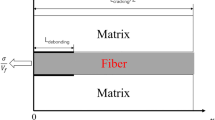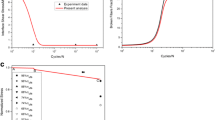Abstract
Today there exists a strong technological need to develop ceramic and metal matrix composites that are reinforced by continuous-length ceramic fibers and that display thermostructural behavior better than conventional high-temperature materials, such as nickel-based superalloys. To achieve these high-performance, high-temperature composites (HTC), numerous research and development programs are in progress throughout the world to address three primary technical areas: (1) measurement and understanding of the various factors controlling the thermostructural behavior of the HTC and its constituents, i. e., fiber, matrix, and interphase; (2) mechanism-based models to describe and predict the behavior of the individual constituents and their performance as an integrated composite system; and (3) innovative process and design approaches for optimizing high temperature behavior. As with any high-performance composite, the fiber is the principal load-bearing constituent so that major emphasis is being placed on research efforts aimed at the measurement, modeling, and improvement of the thermostructural properties of advanced ceramic fibers.
Access this chapter
Tax calculation will be finalised at checkout
Purchases are for personal use only
Preview
Unable to display preview. Download preview PDF.
Similar content being viewed by others
References
M. Takeda, Y. Imai, H. Ichikawa, T. Ishikawa, N. Kasai, T. Seguchi, and K. Okamura, Thermal stability of the low oxygen silicon carbide fibers derived from polycarbosilane, Ceram Eng Sci Proc, 7-8:209(1992).
J.A. DiCarlo, Property goals and test methods for high temperature ceramic fiber reinforcement, to be published in: Proceedings of 8th CIMTEC Conference, 1994.
A.G. Evans, Slow crack growth in brittle materials under dynamic loading conditions, Int. J. Frac. 10:251(1974).
H.M. Yun, J.C. Goldsby, and J.A. DiCarlo, Tensile creep and stress-rupture behavior of polymer derived SiC fibers, to be published in: “Advances in Ceramic Matrix Composites 11, Ceramic Transactions (1994)”; also NASA TM 106692 (1994).
F.A. Kandil and B.F. Dyson, Tensile creep of ceramics: the development of a testing facility, in: “Mechanical Testing of Engineering Ceramics at High Temperatures”, Elsevier Applied Science, London, 151(1989).
G.N. Morscher, H.M. Yun, and J.C. Goldsby, Viscoelastic analysis of bend stress relaxation and tensile primary creep of a polycrystalline α-SiC fiber, in: Proceedings of this conference.
R. Bodet, X. Bourat, J. Lamon, and R. Naslain, Tensile creep behavior of a silicon carbide-based fiber with a low oxygen content, in: R. Bodet PhD thesis, Domaine Universitaire, France (1993).
G. Grathwohl and F. Thummler, Creep of reaction-bonded silicon nitride, in: “Ceramics For High Performance Applications-II”, J.J. Burke, et al, eds., Brook Hill Publishing, Chestnut Hill, Massachusetts, 573(1978).
J.A. DiCarlo and S. Dutta, Continuous ceramic fibers for ceramic composites, in: “Handbook on Continuous Fiber-Reinforced Ceramic Matrix Composites”. CIAC, Purdue University, West Lafayette, Indiana (1994)
J.A. DiCarlo and G.N. Morscher, Creep and stress relaxation modeling of polycrystalline ceramic fibers, in: “Failure Mechanisms in High Temperature Composite Materials”, G.K. Haritos, et al, eds., AD-22, AMD-122, ASME, New York, 15(1991); also NASA TM 105394 (1991).
J.A. DiCarlo, H.M. Yun, G.N. Morscher, and J.C. Goldsby, Tensile creep modeling of SiC fibers, in: NASA HITEMP Conference Proceedings, 1994.
J.B. Conway, “Numerical Methods For Creep And Rupture Analysis”, Gordon and Breach, New York (1967).
S.J. Strait, C.A. Lewinsohn, and C.E. Bakis, Modeling of creep in ceramic matrix composites, in: NASA HITEMP Conference Proceedings, NASA CP 19117, 72(1993).
Author information
Authors and Affiliations
Editor information
Editors and Affiliations
Rights and permissions
Copyright information
© 1995 Springer Science+Business Media New York
About this chapter
Cite this chapter
DiCarlo, J.A., Yun, H.M. (1995). Issues for Creep and Rupture Evaluation of Ceramic Fibers. In: Bradt, R.C., Brookes, C.A., Routbort, J.L. (eds) Plastic Deformation of Ceramics. Springer, Boston, MA. https://doi.org/10.1007/978-1-4899-1441-5_54
Download citation
DOI: https://doi.org/10.1007/978-1-4899-1441-5_54
Publisher Name: Springer, Boston, MA
Print ISBN: 978-1-4899-1443-9
Online ISBN: 978-1-4899-1441-5
eBook Packages: Springer Book Archive




